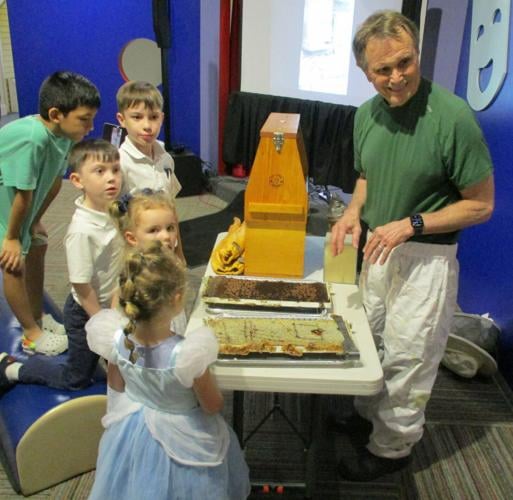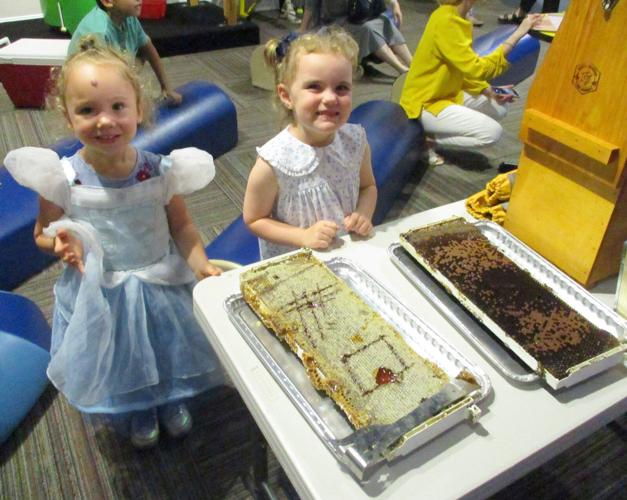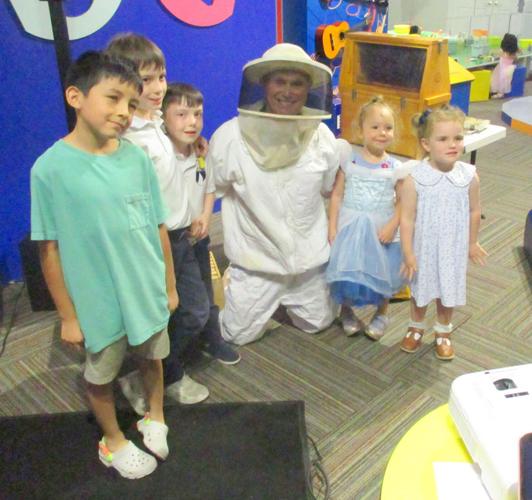For Richard Mannino, bees are the most important animals on planet Earth.
Mannino made the declaration as he began a lecture April 17 on bee keeping at the Louisiana Children’s Discovery Center in Hammond.
Mannino, a pharmacist by profession and a bee hobbyist by choice, offered a detailed presentation of the art of keeping bees and harvesting honey to a group of children at the center.
The children generally paid close attention as Mannino related the role that bees play in support of food production.
Honey, he explained, is the end result of what bees do during their short life span. “Bees literally work themselves to death to make sure that their hive will survive and in the process they do some good things for every one of us,” Mannino said as he explained the important role that bees play in pollinating plants that provide food for humans.
He told the children how the bees gather pollen from plants and in doing so spread the pollen to other plants helping the plant to grow fruit and other things that all people eat.
“This is a good time of the year to study bees because now that spring has come, they have to work very hard to produce enough homey to get through the winter when they can’t find enough pollen to keep the hive going strong,” Mannino said.
Bees have a hard life. "In the beginning of their life they have to find their way out of the wax cell where their life started and then have to go to work. Different bees have different jobs in the hive, but most of them have to work all the time gathering pollen and bringing it back to the hive,” he explained.
Besides making honey, the bees somehow know how to make wax and use the wax to construct symmetrical cells where new bees are raised and honey is stored. The honey is the lifeline for the bee colony.
“Being as busy as a bee helps to explain just how much they have to work. They have to go out every day and fly back and forth bringing the pollen back to the hive. They get very little rest and that is why a bee will live for only a few weeks and maybe six months at the most,” Mannino said. Not all bees have to work, Mannino said, pointing out that the queen, who can live up to three years, is cared for by the other bees while the drones do nothing but wait for the chance to mate with the queen.
To make a bee’s life even more difficult, habitat change with the result that pollen is more difficult to collect in many areas has forced the bees to work harder than in times past, according to Mannino. Mannino said many beekeepers lose 40 to 50% of their hives each year.
The children were especially interested in the equipment that a beekeeper must maintain. Mannino explained how a hive works and showed the children the wooden frames that are placed in special boxes providing the bees a structure on which to build the wax cells where honey is stored. He brought out two cells filled with honey, lightly cut the wax cap from some of the cells, and invited the children to taste the fresh honey. Beekeepers use spinning devices to force the honey from the cells after the wax holding the honey is carefully scrapped away, he informed.
Mannino showed a tool beekeepers use to pull the frames from the hive and showed how a smoker, an important tool for a beekeeper, works. The smoke causes the bees to be docile, Mannino said, adding, “bees can be mean. They have stingers that can hurt.”
He ended his lecture opening the sides of the box containing an active beehive and the children could get close to the glass keeping the bees inside and watch them at work in the hive.
Mannino donned the bee suit he wears when collecting homey from hives. The suit, he explained, allows a keeper to work with bees and not get stung.
He concluded his talk by observing, “bee keeping is an incredibly interesting hobby and is one of the most rewarding things that a person can do. Bees are fascinating and the things they do almost seems life magic. Everyone should be grateful for what bees do for all of us,” he said.



